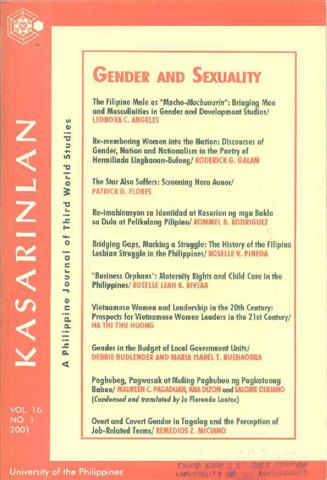Re-Imahinasyon sa Identidad at Kasarian ng mga Bakla sa Dula at Pelikulang Pilipino
Abstract
For years, most voices from the gay liberation movement were made basically to counter oppression and homophobia. This "fallen state" of the gay community has been used as springboard of actions for change and "gay studies." This approach has failed to provide definitive philosophical answers to basic questions on gender identity-- the identity of the individual and his/her work, particularly in the Philippine context. Rodriguez sees a trap in the obsession with this kind of liberation and looking at gays as "special persons." Oppression, although an essential element in the gay experience, is merely symptom, he contends. This paper seeks to make a radical departure from the traditional oppression-based discourse on homosexuality en route to a deeper, indigenous aesthetics, gender studies and a new way of looking at the bakla.Initially the paper used the idea of gender as a social construct woven by collective consciousness. Accordingly, it is also acted upon by power relations which is the province of politics. This is where issues on oppression can be drawn. Aesthetics is rooted in politics. Society accepts and prohibits actions of its members
based on their gender, which is what aesthetics, or that by which society imposes what is acceptable or not, is all about. A gender can be considered unacceptable and something to be suppressed. Plays and films support or contest this construction
on that gender. The author noted the strong metaphor of the castrated male in gay plays and films. This means the stereotypical depiction of the bakla as hysterical, a disease,
laughable and abnormal. The author says this is necessary to give shape to the bakla being an outcast and to the heterosexual as normal. However to make this oppression as basis for the movement for change would leave out questions that would still need to be answered even after the oppression is over, questions such as what is the bakla as gender? Rodriguez then puts forward the concept of "sign" to define the bakla gender using plays and films. He says that plays and films are a sign or symbols, although arbitrary, for society. From these works can be gleaned overt and hidden discourses
on the social castration of the bakla, whether these works contest or unconsciously support such castration. However, Rodriguez contends that these works must be seen beyond their representational or ethic aspect-ethic meaning a more
liberating way of looking at the bakla as gender. He makes a radical departure from these aspects by saying that gender is not the issue but sexual difference is. Citing Moria Gatens, he says that it is body that create and dictate social acts, and culture at the same time. The body creates society and not otherwise. This kind of change in consciousness is what Rodriguez contends as necessary in the problematization and theorization regarding the bakla. He contends that the bakla quality, therefore, is not a matter of gender identity but of sexual difference. To pin the issue at identity, he says, would result only in the further "boxing" of the bakla, the kind which is binary, or which makes one one, if it is not the other. Rodriguez then views art-plays and films-as that which lays down the materials for this discursive path. Plays and films are text that lays itself down as channel through which the viewers realize their imagination particularly on the issue of the gender identity of the bakla and issue of sexual difference. Rodriguez then suggests this kind of discourse "consciousness. by which to view
the plays and films he had selected. In providing contexts for the analysis of the works, he exemplifies what he calls as drawing out and drafting of an aesthetics and criticism on gay films and plays. Analysis of the character still grounds itself on the traditional way a character is viewed based on his relations with him - or herself (body and consciousness), other characters and his/her environment (society). His last chapter features the need for historical tracking of the conceptualization
of the bakla in the Philippines en route to a re-imagining of it. Rodriguez suggests a sexual reading (body as channel of discourse) of the historical texts, which he says, clearly layout discourse on the bakla subject. The bakla will therefore be re-imagined as a sexual text within the literary history of the Philippines. Rodriguez says this historical conception of bakla literature should also be moored on the context of society and popular culture, therefore leading to a re-imagining the bakla as a cultural text. He suggested the collection of testimonials from the gay writers. From all these a re-imagination of the bakla can be made: an indigenous awareness, criticism and theorization of bakla literature and, in general, of bakla as gender.
Published
2008-09-18
Section
Features
Keywords
Bakla; Homosexuality; Cinema; Theater; Representation
By submitting a manuscript, the authors agree that the exclusive rights to reproduce and distribute the article have been given to the Third World Studies Center.



